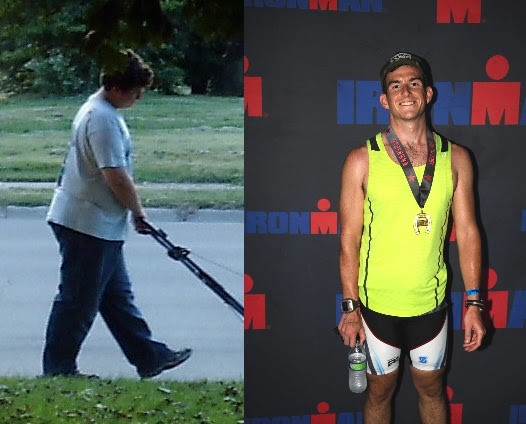HOW TO DEVELOP GOOD HABITS: THE “BIGGEST LOSER PARADOX” IS WHY MOST WRITING GOALS FAIL

In 2002 I was a morbidly obese teenager. Life sucked. Bullying was the norm, food was love, and pop songstress Lizzo wasn’t available to tell me I had the juice because she was in 8th grade at the time. Even if she was espousing body positivity in junior high, social media didn’t exist. I was alone and lost on how to develop good habits.
I eventually broke free of my self-hatred cycle in the summer after my sophomore year when a fast-food job fell through, leaving me with unexpected time on my hands. I began to jog every day at a local track and cleaned up by diet. Through a gradual, methodical process, I lost 105 pounds and have kept it off for 17 years.
The timing was great, because the following year a game show about massive weight loss debuted on national television. I was pumped. A contestant’s schedule on The Biggest Loser was grueling and consisted of over six hours of exercise a day, a deeply restrictive diet, frequent check-ins with doctors, and cameras everywhere. (Jealous!)
It was not unusual for contestants to shed 30, 40, or even 50 percent of their body weight by the end of the season, which is pretty remarkable. “Should I have lost my weight this fast?” I thought to myself. In subsequent years though, the truth about this extreme weight loss began to surface.

Season 15 winner Rachel Frederickson lost 60% of her body weight, sparking international controversy. (Source: NY Daily News)
The truth about the “Biggest Loser Paradox”
Nearly every contestant of The Biggest Loser gained back their weight in the years to come. Long-term medical studies on contestants showed the contestants’ resting metabolisms were permanently damaged. It’s an unfortunate truth about post-obesity lifestyle: 90% — 90 percent! — of people who lose 30+ pounds end up gaining it back.
I assert the two biggest reasons contestants get insane results on The Biggest Loser — and in other extreme challenge scenarios — are that their other life responsibilities are on pause, and they’re getting heaps of encouragement along the way. Both of these conditions evaporate once contestants leave the ranch.
Think about it. There are no unexpected family or personal detours to derail contestants from their weekly weight loss goal. No screaming kids, no job security in flux, no caregiver duties, no traffic. Even their food is tightly controlled. It’s the “Biggest Loser Paradox”, if you will: Extreme bootcamp-style scenarios designed to get fast results rarely deliver long-lasting change.
These contestants got results because they were in a container. And when they left the container and returned to a life of two jobs, two kids, and well-worn habits, their weight crawled back up to where it started. For long-lasting change and improvement, you need a container.
To guarantee long-lasting change, create a container and develop good habits
Trust me: I’m a sucker for immersions, intensives, and workshops. Challenges keep us sharp, and putting my life responsibilities on hold for a few days feels like a vacation in itself, so a workshop or seminar feels like a double-whammy of excitement for me. I’ve lost track of how many yoga workshops, online courses, personal development seminars, and audiobooks I’ve gone through over the years.
Most of these experiences faded away. But the wisdom gleaned from some of these investments stuck with me for years to come. The difference was that I integrated what I had learned into my lifestyle in a steady, intentional way.
What do I mean by container? Think rituals, guardrails, or routines that help your changes and improvements stick. One of my containers during my weight loss journey was to ‘drown hunger’; before any meal or snack I would kick back a full glass or two of room-temperature water. I found this helped to curb hunger pangs.
Simple containers work for writing, too, and can make your writing routine sing rather than suck. Here are a few ways to define a container of your own.
3 ways to create good habits and a writing container
#1: Identify new and interesting goals
The main reason I’ve sustained my weight loss over the years is that I sought out different goals and challenges. In 2013 and 2014, for example, my fitness fix became triathlons. I bought all the gear, picked out destination races, and eventually completed a full-distance Ironman. But then in 2015 and 2016, I did an about-face, and yoga captured my attention. It became more healing and fun to connect with my body as it moved through space.
If you wake up two days in a row uninspired about your end goal, it’s time to throw the goal out the window and recalibrate your inspiration. When you’re inspired, the daily grind feels weightless and exciting, and you want to spend as much time in that space as possible. Prioritize the fire under your butt — It does wonders for making progress.

(Image from the author)
#2: Make integration the priority
We’re addicted to crossing things off our to-do list, and we get a rush of endorphins every time we feel we make progress. But in true habit change, the work is never done, so you need to give the adrenaline rush up; your new quest is to methodically incorporate new behaviors and triggers into your lifestyle.
Give yourself some grace and invest more of your energy and willpower into the integration process. If your goal is writing, maybe it’s better to kick out 200 words daily amidst day-job chaos than it is to procrastinate all week and then try to beast out 2,000 words over the weekend, only to discover you’ve written a bunch of garbage. (Speaking from experience on that one.)
Over time, you’ll learn to adjust for days where you’re sick, not feeling it, or getting nailed by the perils and distractions of stay-at-home life. The only way you’ll discover these nuances and become consistent is to navigate the challenges of day-to-day integration.
#3: Rebalance input and output
Do you feel tired? Do you brainstorm ideas quickly, have good writing hygiene, and still find yourself getting stuck? You might need to switch gears and go into “receiving mode” for a little while.
Good writers talk about how much they read, and subsequently, they pump out superhuman word counts with bionic consistency. If you find yourself feeling depleted or uninspired, perhaps it’s time to pause, invest some energy and resources back into yourself, and get back into a space of discovery. Books, articles, and other stories are a great way to do that. (I’m also not above a good inspirational montage on YouTube.)
You’ll find it much easier to get motivated when you’ve given your focusing muscles time to recover. Recalibrate your balance of input and output every once in a while and you’ll discover reserves of energy you never knew you had.
It can be thrilling to watch others transform their lives in the blink of an eye, especially in a curated television setting. Lasting transformations, however, rarely happen that quickly. Progress comes from having a container and being flexible along the way; bring this approach to your writing pursuits and you’ll develop habits that stick with you and help you go the distance.

